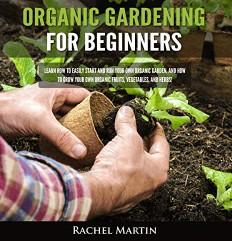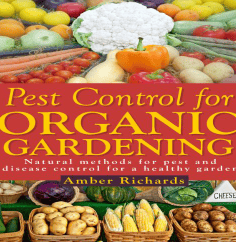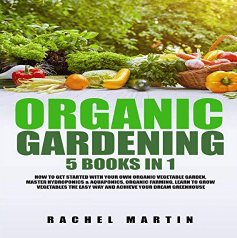How to Grow Sugar Snap Peas – Grow and Care
Chapters
- ¿Qué son los guisantes dulces?
- Vídeo: Cómo cultivar guisantes dulces
- Cómo plantar guisantes dulces
- Plantas complementarias para los guisantes dulces
- Riego, apoyo y fertilización de guisantes dulces
- Cultivo de guisantes dulces en una olla
- Cultivo de guisantes dulces en casa
- Cómo cuidar los guisantes dulces
- Cómo cosechar guisantes dulces
- Plagas y enfermedades de los guisantes dulces
- Aprenda todo lo que necesita saber sobre la jardinería orgánica de la mano de profesionales
- Lista de los mejores audiolibros sobre jardinería orgánica
What are Sugar Snap Peas?
Sugar snap peas are a cultivar of pea eaten whole in its pod while still unripe. They are crisp, sweet, and can be eaten raw or cooked. This type of pea is different from snow peas and garden peas primarily in the thickness and edibility of the pod.
Video: How to Grow Sugar Snap Peas
How to Plant Sugar Snap Peas

Planting sugar snap peas is a rewarding gardening activity because these peas are not only delicious but also fairly easy to grow. Here’s a detailed step-by-step guide on how to plant sugar snap peas:
Step-by-Step Guide to Planting Sugar Snap Peas
1. Choose the Right Time
- Spring Planting: Plant sugar snap peas as early as the ground can be worked in spring. They thrive in cool weather and can tolerate light frosts, so aim for 4 to 6 weeks before the last expected frost date.
- Fall Planting: For a fall crop, plant about 8 to 10 weeks before the first expected frost date in your area.
2. Select an Appropriate Site
- Sunlight: Choose a location that receives at least 6 hours of sunlight per day. Peas grow best in full sun but can tolerate partial shade.
- Soil: The soil should be well-draining and rich in organic matter. Sugar snap peas prefer a soil pH between 6.0 and 7.5.
3. Prepare the Soil
- Soil Amendment: Work compost or aged manure into the soil to improve fertility and drainage. This step is crucial for healthy growth and optimum yields.
- Tilling: Loosen the soil to a depth of about 12 inches to allow for good root development.
4. Sow the Seeds
- Planting Depth and Spacing: Sow seeds about 1 inch deep and 2 inches apart. If you are planting multiple rows, space the rows about 18 to 24 inches apart.
- Watering After Planting: Water the area gently but thoroughly after planting to settle the soil around the seeds.
5. Provide Support
- Support Structures: Since sugar snap peas are climbing plants, set up trellises, stakes, or a fence at planting time for the peas to climb on. This support should be about 4 to 6 feet high.
6. Care After Planting
- Initial Care: Keep the soil moist, especially during germination and early growth. Avoid letting the soil dry out, as this can impact the health of the plants.
- Mulching: Once the plants are a few inches tall, apply a layer of organic mulch around them to help retain moisture, keep the soil cool, and suppress weeds.
7. Watch for Germination
- Germination Time: Expect seedlings to emerge in about 7 to 10 days, depending on soil temperature. Cooler soil will delay germination.
By following these steps, your sugar snap peas will be well on their way to providing a bountiful and tasty harvest. Regular care following planting will ensure that your pea plants remain healthy and productive throughout the growing season.
Check out the video to see how you can grow your Sugar Snap Peas together with Corn. They make excellent companion plants as the Sugar Snap Peas can use the Corn as support.
Companion Plants for Sugar Snap Peas
Planting sugar snap peas near other plants can be beneficial. Good companions include:
- Cilantro;
- Mint;
- Radish;
- Lettuce;
- Spinach;
- Corn;
- Beans;
- Cucumber.
Do not plant peas next to:
- Onions
- Potatoes
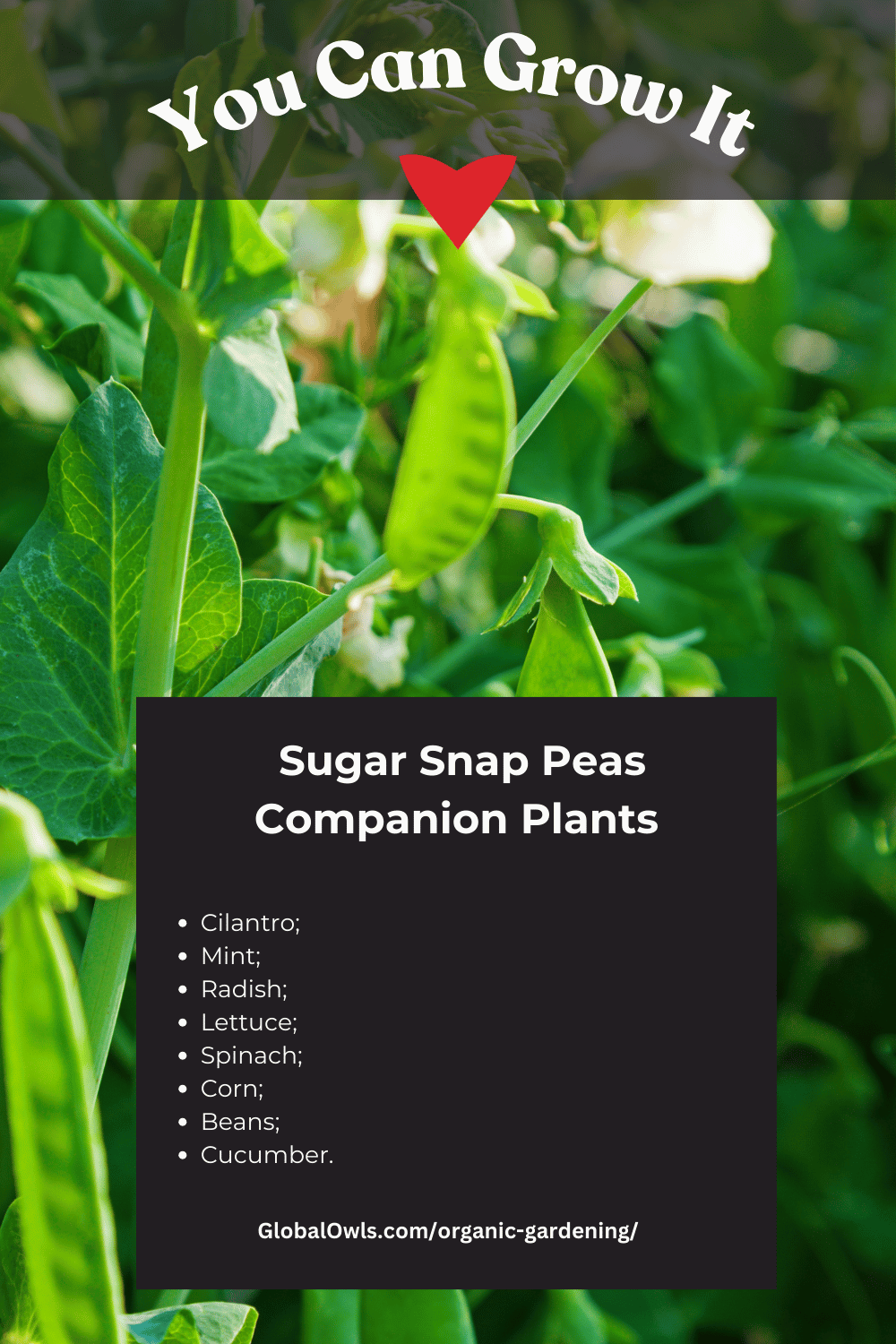
Sugar Snap Peas Watering, Support, and Fertilizing
- Watering: Keep the soil consistently moist but not waterlogged. Water at the base to avoid wetting the foliage.
- Support: Provide support with trellises or stakes as sugar snap peas are climbing plants.
- Fertilizing: Use a low-nitrogen or balanced fertilizer at planting and mid-season after the first pods appear.
Growing Sugar Snap Peas in a Pot
- Container Size: Choose a container at least 12 inches deep and wide.
- Soil: Use high-quality potting soil with good drainage.
- Support: Place a trellis or stakes in the pot for the peas to climb.
- Care: Ensure the plants receive at least six hours of sunlight, keep the soil moist, and fertilize as needed.
Growing Sugar Snap Peas at Home
In addition to pots, sugar snap peas can thrive in raised beds or traditional garden plots. Ensure they have ample sun, regular watering, and trellis support for the best yield.
How to Care for Sugar Snap Peas
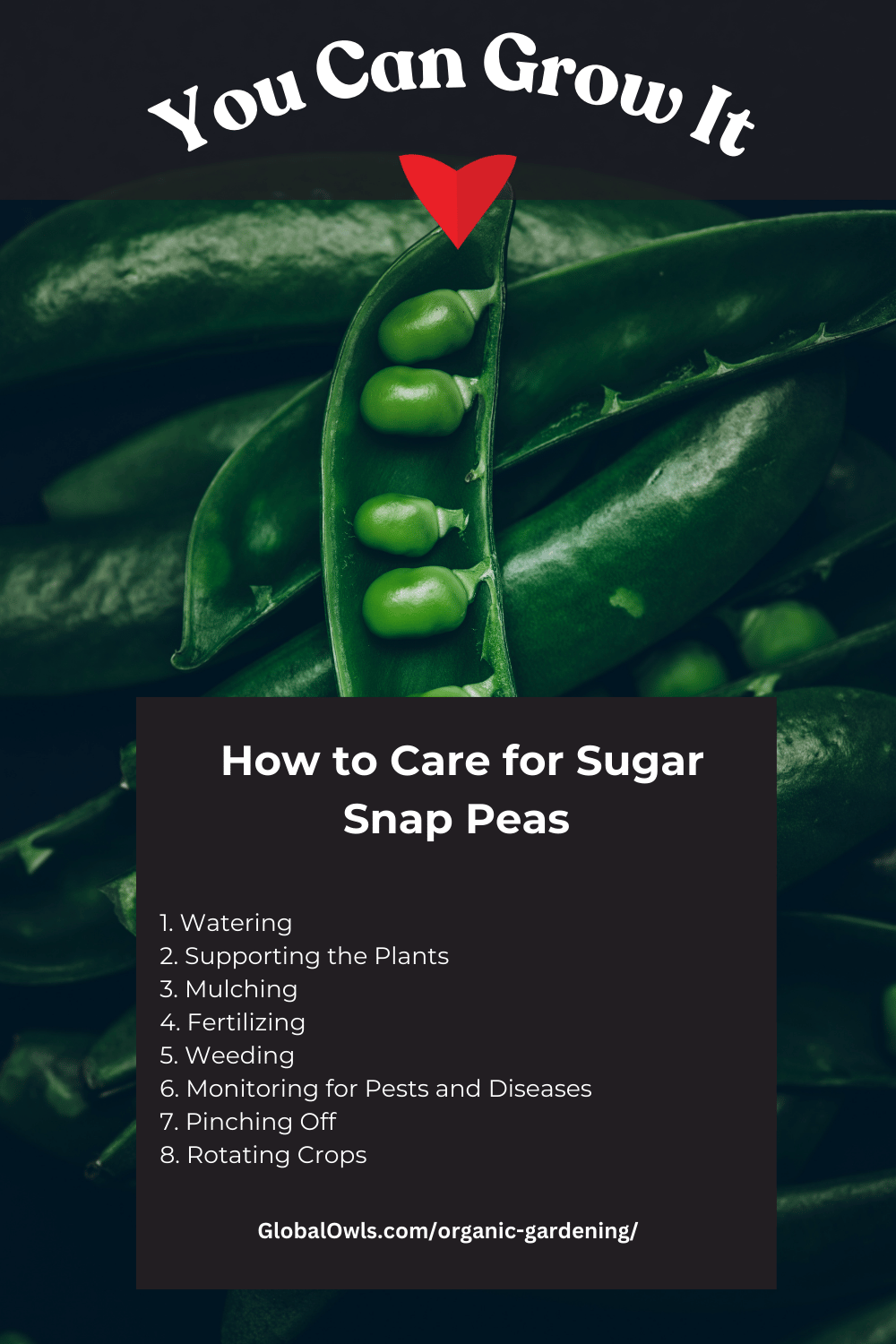
Caring for sugar snap peas involves a few key practices to ensure they grow healthy and produce a good yield. Here’s a step-by-step guide on how to properly care for sugar snap peas:
Step-by-Step Guide to Caring for Sugar Snap Peas
1. Watering
- Consistency is Key: Sugar snap peas need consistent moisture, especially when the plants are flowering and developing pods.
- Amount and Frequency: Water deeply once a week, providing about an inch of water each time, more frequently if the weather is particularly hot or dry.
- Method: Water at the base of the plants to avoid wetting the foliage, which can promote fungal diseases.
2. Supporting the Plants
- Install Supports Early: If you didn’t set up trellises, stakes, or nets at planting time, do it as soon as the plants begin to grow.
- Training Vines: Gently guide the growing shoots onto the support structures. They will begin to climb naturally using their tendrils.
3. Mulching
- Purpose of Mulching: Mulch helps to maintain soil moisture, control weeds, and keep the root system cool.
- Materials: Use organic mulch such as straw, shredded leaves, or grass clippings.
- Application: Apply a 2-3 inch layer of mulch around the base of the plants, being careful not to smother the young shoots.
4. Fertilizing
- Fertilizer Selection: Choose a low-nitrogen or balanced fertilizer. Peas fix their own nitrogen, so excessive nitrogen can reduce flowering.
- Application Timing: Fertilize when the plants are about 4-6 inches tall and again when they begin to flower.
- Application Method: Apply according to package instructions, typically around the base of the plants, and water in well.
5. Weeding
- Weeding Needs: Keep the area around the peas free of weeds, which compete for nutrients, water, and light.
- Weeding Method: Hand pull or use a hoe to gently remove weeds. Be careful not to disturb the pea plant roots.
6. Monitoring for Pests and Diseases
- Common Pests: Watch for aphids, pea weevils, and spider mites. Treat infestations early with insecticidal soap or neem oil.
- Disease Prevention: Prevent diseases like powdery mildew by ensuring good air circulation around the plants and avoiding overhead watering.
- Regular Checks: Inspect your plants regularly for signs of stress or disease, and take action promptly to resolve issues.
7. Pinching Off
- Promote Bushier Growth: Pinch off the tips of the plants when they are about 6 inches tall to encourage bushier growth and more pods.
8. Rotating Crops
- Avoid Soil-Borne Diseases: Do not plant peas in the same spot every year. Rotate crops to different parts of your garden to minimize the risk of soil-borne diseases.
By following these steps, your sugar snap peas will be well-maintained, leading to a healthy plant and a fruitful harvest. Regular care not only promotes growth but also minimizes issues, making your gardening experience more enjoyable and successful.
How to Harvest Sugar Snap Peas
- Timing: Harvest when pods are plump but before they start to diminish in sweetness.
- Method: Hold the vine with one hand and the pod with the other to avoid pulling off the vine.
- Frequency: Check plants every 1-2 days as peas can mature quickly.
Sugar Snap Peas Pests and Diseases
- Pests: Common pests include aphids and pea weevils. Use insecticidal soap or neem oil for control.
- Diseases: Watch for powdery mildew and root rot. Improve air circulation and soil drainage to prevent these issues.
FAQ
What are the basic requirements for growing sugar snap peas?
Sugar snap peas thrive in cool weather, preferring temperatures between 55°F and 65°F (13°C and 18°C). They need well-drained, fertile soil with a pH of 6.0 to 7.0 and at least six hours of sunlight per day.
How do you plant sugar snap peas?
Plant sugar snap pea seeds directly in the ground about 1 to 1.5 inches deep and 2 inches apart in rows. Ensure the planting site is in a location that receives full sunlight and has support structures like trellises for the vines to climb.
Can sugar snap peas be grown in containers?
Yes, sugar snap peas can be grown in containers. Choose a deep pot with at least 8 inches of soil depth and provide a climbing support. Ensure the container has good drainage and place it in a location that receives ample sunlight.
What are the best varieties of sugar snap peas to grow?
Popular varieties of sugar snap peas include ‘Sugar Ann,’ ‘Super Sugar Snap,’ and ‘Cascadia.’ Each variety has its strengths, such as disease resistance and pod size, so choose based on your local climate and taste preference.
How do you care for sugar snap peas?
Keep the soil consistently moist but not waterlogged. Support the plants with a trellis or stakes as they grow to encourage upward growth. Mulch around the plants to retain moisture and control weed growth.
When is the best time to plant sugar snap peas?
The best time to plant sugar snap peas is as soon as the soil can be worked in early spring. For a fall harvest, plant them about 8 weeks before the first expected frost.
How long does it take for sugar snap peas to mature?
Sugar snap peas typically take about 60 to 70 days from planting to maturity. This can vary slightly depending on the variety and growing conditions.
What common pests affect sugar snap peas?
Common pests include aphids, pea weevils, and spider mites. Manage pests by using insecticidal soap or neem oil and encouraging beneficial insects like ladybugs in your garden.
Can sugar snap peas be used as a companion plant?
Yes, sugar snap peas make excellent companion plants for many vegetables. They work well with corn, cucumbers, and radishes but should not be planted near onions or garlic as they can inhibit growth.
How do you harvest sugar snap peas?
Harvest sugar snap peas when the pods are plump and the peas inside have developed but are not bulging. Pick them gently to avoid damaging the plant, and frequent harvesting encourages the plant to produce more pods.
How often should sugar snap peas be watered?
Water sugar snap peas regularly to maintain moist but not soggy soil. Typically, watering once a week is sufficient, but you may need to adjust frequency based on weather conditions and soil type.
What type of fertilizer is best for sugar snap peas?
Sugar snap peas benefit from a low-nitrogen or balanced fertilizer. Apply at planting and again when the plants begin to flower. Avoid high nitrogen fertilizers, which can promote leaf growth at the expense of pod production.
How do I train sugar snap peas to climb?
As the vines begin to grow, gently guide them towards your trellis or support system. You can loosely tie the vines to the support with soft garden twine to encourage them to climb.
What are the signs of overwatering in sugar snap peas?
Signs of overwatering include yellowing leaves, stunted growth, and root rot. If you notice these symptoms, reduce your watering frequency and ensure your soil has good drainage.
Can sugar snap peas survive a frost?
Sugar snap peas are frost-tolerant and can survive light frosts, making them ideal for early spring planting. However, a hard frost can damage the plants, so provide some protection if a late hard frost is expected after planting.
What soil amendments improve the growth of sugar snap peas?
Adding compost or well-rotted manure to the soil before planting improves soil fertility and structure, promoting healthy growth. A layer of mulch can also help retain soil moisture and suppress weeds.
How do I deal with diseases affecting sugar snap peas?
Common diseases include powdery mildew and root rot. Prevent disease by ensuring proper spacing for air circulation and practicing crop rotation. If diseases appear, treat with appropriate fungicides and remove affected parts promptly.
When is the best time to mulch around sugar snap peas?
Apply mulch around sugar snap peas after the soil has warmed up in spring. This helps retain moisture, keep roots cool, and suppress weeds during the growing season.
How can I organically control pests on sugar snap peas?
Organic pest control options include introducing beneficial insects like ladybugs and using row covers to protect the plants from pests. Sprays made from neem oil or insecticidal soap can also be effective when applied early in the infestation.
What is the best way to store harvested sugar snap peas?
Sugar snap peas are best eaten fresh but can be stored in the refrigerator for a few days. For longer storage, blanch the pods for 1-2 minutes, then plunge them into ice water, drain, and freeze in airtight containers.
What is the ideal spacing between sugar snap pea plants?
For optimal growth, space sugar snap pea seeds or seedlings approximately 2 inches apart within rows. Rows should be spaced about 18-24 inches apart to allow for adequate air circulation and ease of harvesting.
How can I ensure a continuous harvest of sugar snap peas?
To ensure a continuous harvest, practice successive planting every 2-3 weeks during the cool seasons of early spring and fall. This staggers the maturity of the crops, providing a steady supply of peas.
Are sugar snap peas sensitive to any particular nutrients?
Sugar snap peas benefit from phosphorus and potassium, which support strong root development and improve overall plant health. However, they are sensitive to excess nitrogen, which can promote leaf growth over pod production.
What climatic conditions are best for growing sugar snap peas?
Sugar snap peas prefer cool, temperate climates with temperatures ranging from 55°F to 65°F (13°C to 18°C). They perform best in regions with mild springs and autumns and can tolerate light frosts.
How do I prevent my sugar snap peas from becoming tough and stringy?
Harvest sugar snap peas regularly when they are young and tender, before the peas inside fully mature. Over-mature pods can become tough and stringy. Consistent watering and harvesting can help maintain pod quality.
Can sugar snap peas be grown vertically in smaller spaces?
Yes, growing sugar snap peas vertically on trellises, nets, or stakes is an excellent way to maximize yield in small garden spaces. This method also improves air circulation, which can help prevent disease.
What should I do if my sugar snap pea plants are flowering but not producing pods?
If plants are flowering but not setting pods, this could be due to high temperatures or insufficient pollination. Ensure bees and other pollinators have access to your garden, and consider hand-pollinating flowers if necessary.
How do sugar snap peas contribute to soil health?
Sugar snap peas, like other legumes, have the ability to fix atmospheric nitrogen into the soil through a symbiotic relationship with root bacteria. This natural process enriches the soil, reducing the need for nitrogen fertilizers.
What companion plants are beneficial for sugar snap peas?
Planting sugar snap peas with carrots, radishes, and cucumbers can be beneficial. These companions can help utilize space efficiently, and the radishes, in particular, can help mark the rows and loosen the soil.
How can I revive sugar snap pea plants that seem to be wilting?
Wilting plants may need more water, especially in warmer weather. Ensure the soil is moist but not waterlogged. If watering is consistent, check for signs of disease or pests, and treat accordingly.
Learn everything you need to know about Organic Gardening from Pros
Start your Free Audible Trial and get access to the Top Gardening Audio Books for an entire month. Check it out!
